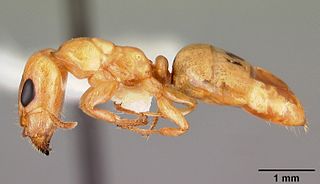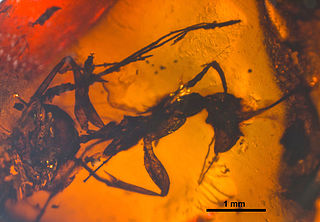
The Formicinae are a subfamily within the Formicidae containing ants of moderate evolutionary development.

Ponerinae, the ponerine ants, is a subfamily of ants in the Poneromorph subfamilies group, with about 1,600 species in 47 extant genera, including Dinoponera gigantea - one of the world's largest species of ant. Mated workers have replaced the queen as the functional egg-layers in several species of ponerine ants. In such queenless species, the reproductive status of workers can only be determined through ovarian dissections.

Myrmicinae is a subfamily of ants, with about 140 extant genera; their distribution is cosmopolitan. The pupae lack cocoons. Some species retain a functional sting. The petioles of Myrmicinae consist of two nodes. The nests are permanent and in soil, rotting wood, under stones, or in trees.

Dolichoderinae is a subfamily of ants, which includes species such as the Argentine ant, the erratic ant, the odorous house ant, and the cone ant. The subfamily presents a great diversity of species throughout the world, distributed in different biogeographic realms, from the Palearctic, Nearctic, Afrotropical region and Malaysia, to the Middle East, Australian, and Neotropical regions.
Barry Bolton is an English myrmecologist, an expert on the classification, systematics, and taxonomy of ants, who long worked at the Natural History Museum, London. He is known especially for monographs on African and Asian ants, and for encyclopaedic global works, including the Identification Guide to Ant Genera (1994), A New General Catalogue of Ants of the World, Synopsis and Classification of Formicidae (2003), and Bolton's Catalogue of Ants of the World: 1758-2005 (2007). Now retired, Bolton is a Fellow of the Royal Entomological Society and Myrmecologist, Biodiversity Division, Department of Entomology, Natural History Museum, London.

Plagiolepis is an ant genus of the formic acid-producing subfamily Formicinae. The genus is found in tropical and temperate regions of the Old World.

Dolichoderus is a genus of ants found worldwide.

Sphecomyrminae is an extinct subfamily of ants in family Formicidae known from a series of Cretaceous fossils found in North America, Europe, and Asia. Sphecomyrminae contains eight genera, divided into two tribes Sphecomyrmini and Zigrasimeciini. The tribe Sphecomyrmini contains the six genera Armania, Cretomyrma, Gerontoformica, Orapia, Pseudarmania and Sphecomyrma; while Zigrasimeciini contains Boltonimecia and Zigrasimecia. A number of taxa have been removed from the subfamily and placed either in other subfamilies or are now treated as incertae sedis in Formicidae.

Ectatomminae is a subfamily of ants in the poneromorph subfamilies group containing four extant and three extinct genera in two tribes. The subfamily was described in 2003 when Barry Bolton divided the Ponerinae subfamily into six subfamilies.

Alloformica is a genus of ants in the subfamily Formicinae. The genus was first described as a subgenus of Proformica by Dlussky (1969), later to be synonymized under Proformica by Brown (1973), and finally revived and raised to genus rank by Dlussky & Fedoseeva (1988). Its species are known only from a few localities.

Gesomyrmex is a genus of ants in the subfamily Formicinae. The genus contains six extant species, known from the Indomalayan realm, and nine fossil species. Of the extant species, four are known only from workers and two only from females. The extinct species "G. expectans" and "Gesomyrmex miegi", formerly placed in the genus, were excluded by Dlussky et al.., 2009.

Burmomyrma is an extinct genus of aculeate hymenopteran, suggested to be an ant. The genus contains a single described species, Burmomyrma rossi. Burmomyrma is known from a single Middle Cretaceous fossil which was found in Asia.
Kotshkorkia is an extinct genus of ants of the subfamily Dolichoderinae. The genus contains a single described species Kotshkorkia laticeps. It was described by Dlussky in 1981, where the first fossils of the ant were found in Russia.

Casaleia is an extinct genus of ants in the formicid subfamily Amblyoponinae described by Pagliano & Scaramozzino in 1990 from fossils found in Europe. The genus contains four species dating from the Eocene to Miocene, Casaleia eocenica, Casaleia inversa, Casaleia longiventris, Casaleia orientalis.

Zherichinius is an extinct genus of ants in the subfamily Dolichoderinae known from fossils found in amber from the Middle Eocene of Sakhalin island Far eastern Russia and Bitterfeld, Germany. At the time of description the species Zherichinius horribilis and Zherichinius rapax were two of eight ant species known from Sakhalin fossils.

Ponerini is a tribe of Ponerinae ants with 46 genera and 6 extinct genera.

Dlusskyidris is an extinct genus of ant in the Formicidae subfamily Sphecomyrminae, and is one of the five genera placed in the tribe Sphecomyrmini. The genus contains a single described species, Dlusskyidris zherichini, and is known from three Late Cretaceous fossils which have been found in northern Russia.

Boltonimecia is an extinct genus of ant in the formicid subfamily Zigrasimeciinae. The genus contains a single described species, Boltonimecia canadensis, and is known from a single Late Cretaceous fossil which was found in Canada. The type species was originally described as a species of the extinct genus Sphecomyrma under the combination Sphecomyrma canadensis.














